-
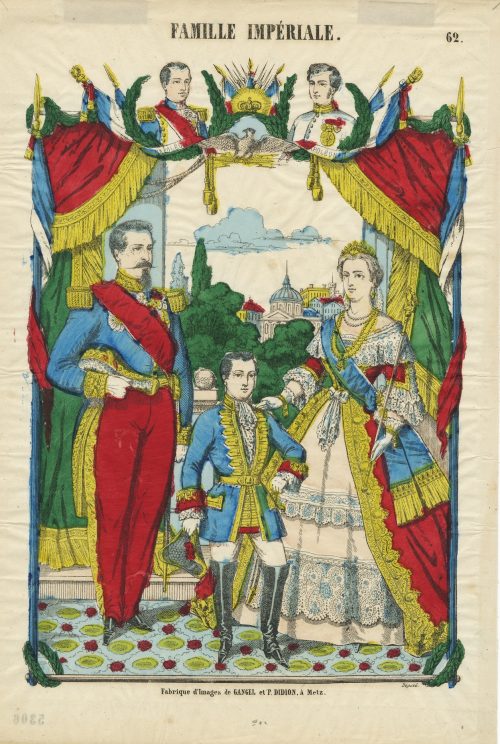 Hand-coloured woodcut on wove paper, 400 x 270 mm; black ink stamp “5306” to reverse. Top centre: "FAMILLE IMPÉRIALE", right: "62."; below centre: "Fabrique d'Images de GANGEL et P. DIDION, à Metz."; right: "Déposé." Publisher/printer: Gangel et P. Didion (Metz); Paulin Didion (French, 1831 – 1879). Characters: Napoleon III [Charles-Louis Napoléon Bonaparte] (French, 1808 – 1873) Eugénie de Montijo [L'impératrice Eugénie] (Spanish-French, 1826 – 1920) Napoléon, Prince Imperial (Napoléon Eugène Louis Jean Joseph Bonaparte] (French, 1856 – 1879) Napoléon II [Napoléon François Joseph Charles Bonaparte] (French, 1811 – 1832) Napoléon Ier [Napoléon Bonaparte] (French, 1769 – 1821)
Hand-coloured woodcut on wove paper, 400 x 270 mm; black ink stamp “5306” to reverse. Top centre: "FAMILLE IMPÉRIALE", right: "62."; below centre: "Fabrique d'Images de GANGEL et P. DIDION, à Metz."; right: "Déposé." Publisher/printer: Gangel et P. Didion (Metz); Paulin Didion (French, 1831 – 1879). Characters: Napoleon III [Charles-Louis Napoléon Bonaparte] (French, 1808 – 1873) Eugénie de Montijo [L'impératrice Eugénie] (Spanish-French, 1826 – 1920) Napoléon, Prince Imperial (Napoléon Eugène Louis Jean Joseph Bonaparte] (French, 1856 – 1879) Napoléon II [Napoléon François Joseph Charles Bonaparte] (French, 1811 – 1832) Napoléon Ier [Napoléon Bonaparte] (French, 1769 – 1821) -
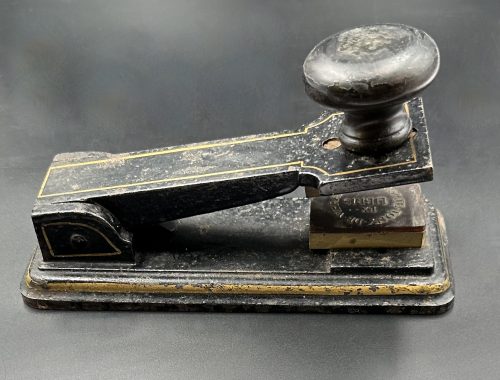 Iron pliers painted black and outlined in gilt lacquer, with wooden handle and bronze seals, "Ex Libris Comte Tony de Vibraye", L17.1 x W6.9 x H7.5 cm. Provenance: Antoine Henri Gaston Hurault de Vibraye [Comte Tony de Vibraye] (French, 1893 – 1951). The book with such a stamp in this library: [LIB-3243.2023] Crébillon fils. La Nuit et le moment ou Les Matinées de Cythère / Illustrations de Sylvain Sauvage. — Paris: Au dépens d’un amateur, 1924.
Iron pliers painted black and outlined in gilt lacquer, with wooden handle and bronze seals, "Ex Libris Comte Tony de Vibraye", L17.1 x W6.9 x H7.5 cm. Provenance: Antoine Henri Gaston Hurault de Vibraye [Comte Tony de Vibraye] (French, 1893 – 1951). The book with such a stamp in this library: [LIB-3243.2023] Crébillon fils. La Nuit et le moment ou Les Matinées de Cythère / Illustrations de Sylvain Sauvage. — Paris: Au dépens d’un amateur, 1924. -
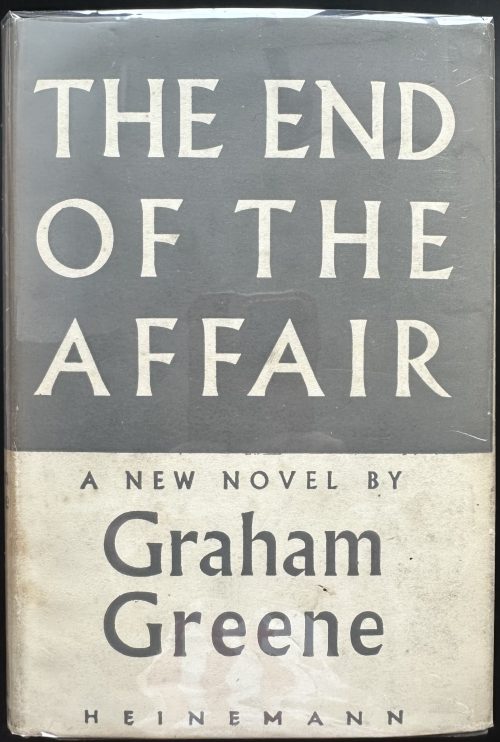 Hardcover volume, 19 x 13 cm, grey cloth with gilt lettering to spine, grey/cream dust jacket lettered throughout, price “10s 6d | NET” unclipped. Covers rubbed, dust jacket has a purple ink stain on the back bottom. Black ink inscription to recto ffl. Collation: a-o8 p10, total 122 leaves; pp.: [6] 1-237 [238]. 1st edition, 1st issue / Great Britain. Title-page: THE END OF THE | AFFAIR | by | GRAHAM GREENE | {publisher’s device} | — | WILLIAM HEINEMANN LTD | MELBOURNE :: LONDON :: TORONTO || Imprint: FIRST PUBLISHED 1951 | PRINTED IN GREAT BRITAIN | AT THE WINDMILL PRESS | KINGSWOOD, SURREY || Dedication: To C. (Catherine Walston, nee Crompton, American, 1925 – 1978) Contributors: Graham Greene (British, 1904 – 1991) William Henry Heinemann (Jewish-British, 1863 – 1920)
Hardcover volume, 19 x 13 cm, grey cloth with gilt lettering to spine, grey/cream dust jacket lettered throughout, price “10s 6d | NET” unclipped. Covers rubbed, dust jacket has a purple ink stain on the back bottom. Black ink inscription to recto ffl. Collation: a-o8 p10, total 122 leaves; pp.: [6] 1-237 [238]. 1st edition, 1st issue / Great Britain. Title-page: THE END OF THE | AFFAIR | by | GRAHAM GREENE | {publisher’s device} | — | WILLIAM HEINEMANN LTD | MELBOURNE :: LONDON :: TORONTO || Imprint: FIRST PUBLISHED 1951 | PRINTED IN GREAT BRITAIN | AT THE WINDMILL PRESS | KINGSWOOD, SURREY || Dedication: To C. (Catherine Walston, nee Crompton, American, 1925 – 1978) Contributors: Graham Greene (British, 1904 – 1991) William Henry Heinemann (Jewish-British, 1863 – 1920) -
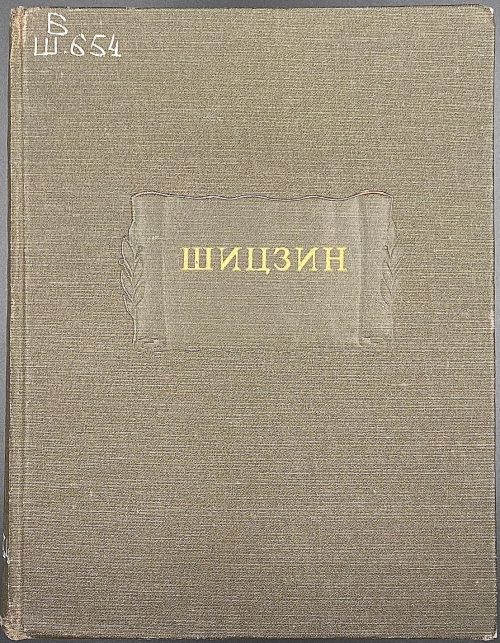 Title (black and red): ШИЦЗИН | [device} | ИЗДАНИЕ ПОДГОТОВИЛИ | А.А. ШТУКИН И Н.Т. ФЕДОРЕНКО | ИЗДАТЕЛЬСТВО АКАДЕМИИ НАУК СССР | МОСКВА | 1957 Title page verso: РЕДАКЦИОННАЯ КОЛЛЕГИЯ СЕРИИ «ЛИТЕРАТУРНЫЕ ПАМЯТНИКИ» (names) Ответственный редактор доктор филологических наук Н. Т. ФЕДОРЕНКО Поэтическая редакция А. Е. АДАЛИС Pagination: [1, 2] – serial h.t / title in Chinese 诗经, [3, 4] – t.p. / editorial board, [5, 6] – editorial / blank, [7, 8] – f.t. / blank, 9-610 [611] [612 colophon]; print run 3,500 copies. Collation: [1]8 2-398. Binding: 23 x 17.5 cm; serial green cloth blind-stamped with a scroll adorned with gold lettering to board and spine. Содержание: От редакции. — С. 5; Шицзин / Пер. A.A. Штукина: Нравы царств. — С. 7-193; Малые оды. — С. 195-325; Великие оды. — С. 327-409; Гимны. — С. 411-466. Приложения: Федоренко Н.Т. «Книга песен». — С. 469-530; Комментарии / Сост. A.A. Штукин, ред. В.А. Кривцов. — С. 531-600.
Title (black and red): ШИЦЗИН | [device} | ИЗДАНИЕ ПОДГОТОВИЛИ | А.А. ШТУКИН И Н.Т. ФЕДОРЕНКО | ИЗДАТЕЛЬСТВО АКАДЕМИИ НАУК СССР | МОСКВА | 1957 Title page verso: РЕДАКЦИОННАЯ КОЛЛЕГИЯ СЕРИИ «ЛИТЕРАТУРНЫЕ ПАМЯТНИКИ» (names) Ответственный редактор доктор филологических наук Н. Т. ФЕДОРЕНКО Поэтическая редакция А. Е. АДАЛИС Pagination: [1, 2] – serial h.t / title in Chinese 诗经, [3, 4] – t.p. / editorial board, [5, 6] – editorial / blank, [7, 8] – f.t. / blank, 9-610 [611] [612 colophon]; print run 3,500 copies. Collation: [1]8 2-398. Binding: 23 x 17.5 cm; serial green cloth blind-stamped with a scroll adorned with gold lettering to board and spine. Содержание: От редакции. — С. 5; Шицзин / Пер. A.A. Штукина: Нравы царств. — С. 7-193; Малые оды. — С. 195-325; Великие оды. — С. 327-409; Гимны. — С. 411-466. Приложения: Федоренко Н.Т. «Книга песен». — С. 469-530; Комментарии / Сост. A.A. Штукин, ред. В.А. Кривцов. — С. 531-600.(Shijing)
-
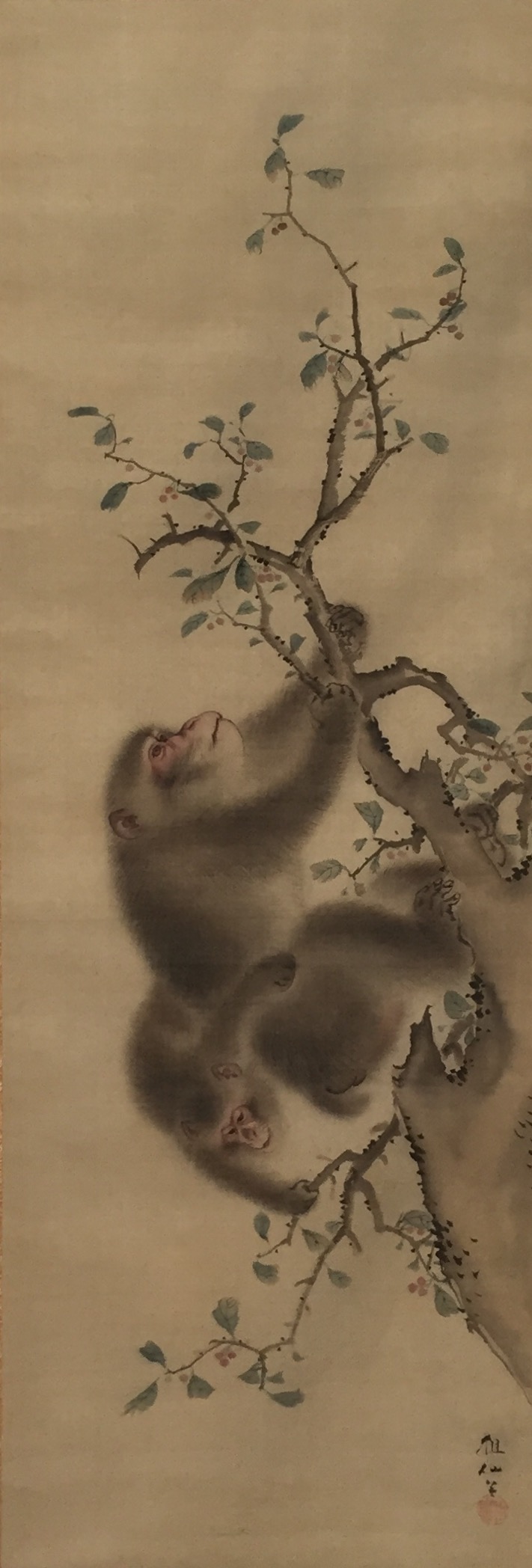 Mori Sosen (1747-1821). Two Monkeys Hanging From Branches. Hanging Scroll Painting. Ink and colour on silk. Signed: Sosen. Sealed: Sosen.
Mori Sosen (1747-1821). Two Monkeys Hanging From Branches. Hanging Scroll Painting. Ink and colour on silk. Signed: Sosen. Sealed: Sosen. -
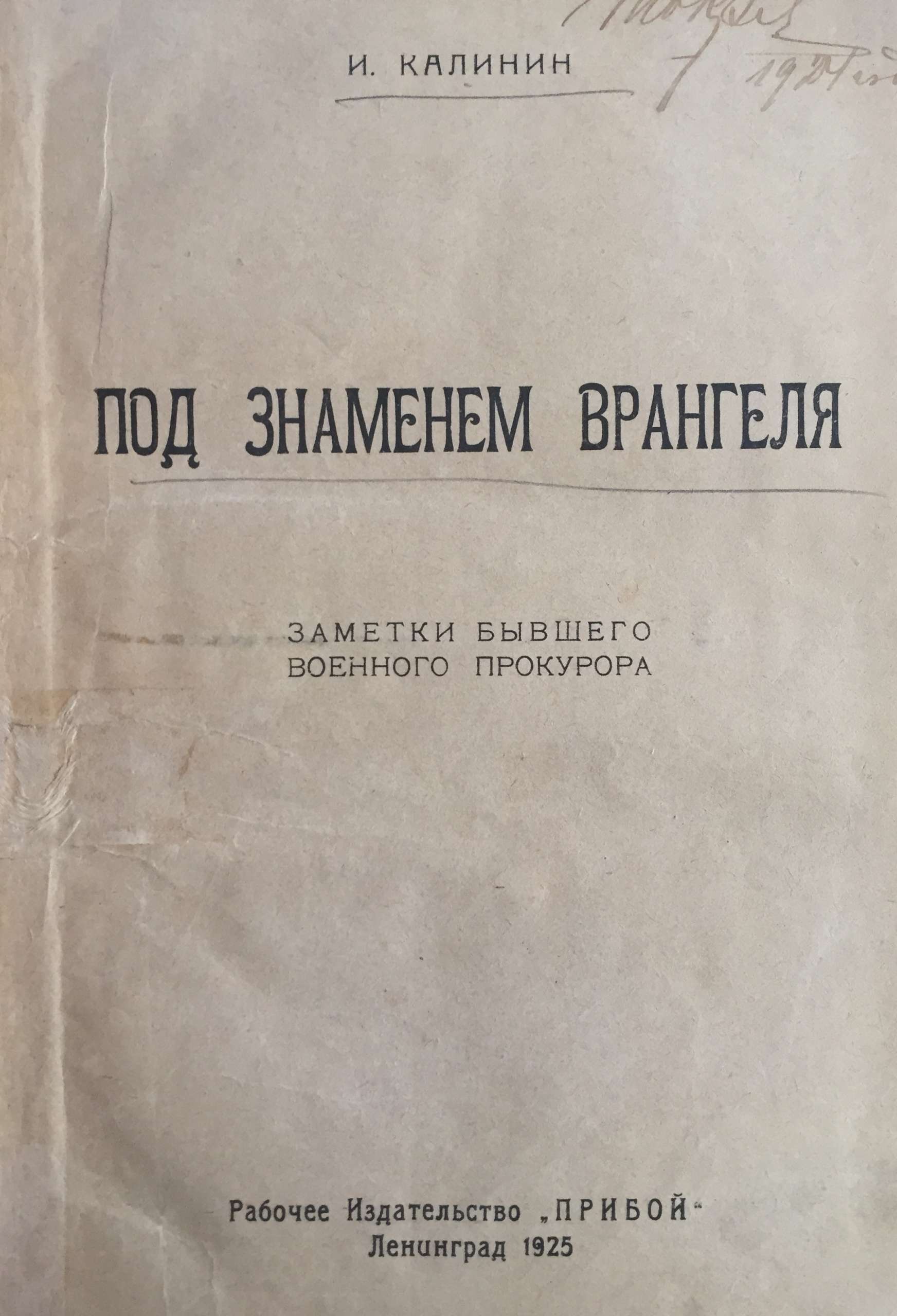
И. М. Калинин. Под знаменем Врангеля. Заметки бывшего военного прокурора. - Л.: Рабочее из-во "Прибой", 1925. - 273 с.
Тираж 7125 экз.
Об авторе: «К моменту февральской революции я занимал должность помощника военного прокурора Кавказского военно-окружного суда... Я не был политиком, но не переносил Союза русского народа. Падение монархии приветствовал. В 1917 году в г. Эрзеруме, занимая довольно приличный пост, работал в самом тесном содружестве с Советом солдатских и рабочих депутатов. Меньшевики, эсэры, большевики постоянно навещали меня, зная, что я хотя и внепартийный, но искренно предан делу революции». В 1918-м Калинину удалось перебраться в занятый Добровольческой армией Екатеринодар, откуда в конце сентября 1918 г. он выехал на Дон. «Здесь тоже мобилизовали всех офицеров. Мне ничего другого не оставалось, как поступить на службу в только что сорганизованный Донской военно-окружной суд». Будучи профессиональным военным юристом Калинин в дальнейшем состоял прокурором при временном Донском военном суде.
По возвращении из эмиграции полковник Калинин, как и многие другие репатрианты, пытался избавиться от клейма «бывшего белогвардейца». 5 октября 1937 г. И. М. Калинин, в то время преподаватель рабочего факультета Ленинградского автодорожного института, был арестован по решению Комиссии НКВД и Прокуратуры СССР . 2 ноября 1937 г. он был приговорен по ст. 58-6-8-11 УК РСФСР к высшей мере наказания и расстрелян в Ленинграде 10 ноября 1937 года.
-
 Shakudō tsuba of the slightly vertically elongated round form (nagamaru-gata) decorated by gold in flat inlay (hira-zōgan) with three insects (cricket, locust, and praying mantis), grass and dewdrops motif. Kogai hitsu-ana is plugged with gilded soft metal. Height: 70.2 mm; width: 66.4 mm x Thickness at seppa-dai: 4.5 mm. Edo period (from ca. 1700 to ca. 1850) Unsigned. Attributed to Kaga School or Murakami School. Almost identical tsuba (no dewdrops, though) is illustrated and described at page 60 of Kokusai Tosogu Kai. 7th International Convention & Exhibition, November 1st, 2011 at Tokyo National Museum, page 60. It is attributed to the Kaga School, Mid Edo period (Late 17th - early 18th century). Dimensions: 70.5 x 66 x 4.5 mm. "The rich black shakudo plate has been slightly lowered (dished out) and then polished. Gold insects crawl amongst grasses, depicted by Kaga style hirazogan (flat inlay). One tendril of the mantis overlaps onto seppa-dai. The mantis boldly looks out from the tsuba in a curious way. This style of Kaga tsuba was popular during the Genroku era (1688-1703)."Another source is Japanese Sword Fittings. A descriptive catalogue of the Collection of G.H. Naunton, Esq., completed and illustrated by Henri L. Joly, - 1912:
Shakudō tsuba of the slightly vertically elongated round form (nagamaru-gata) decorated by gold in flat inlay (hira-zōgan) with three insects (cricket, locust, and praying mantis), grass and dewdrops motif. Kogai hitsu-ana is plugged with gilded soft metal. Height: 70.2 mm; width: 66.4 mm x Thickness at seppa-dai: 4.5 mm. Edo period (from ca. 1700 to ca. 1850) Unsigned. Attributed to Kaga School or Murakami School. Almost identical tsuba (no dewdrops, though) is illustrated and described at page 60 of Kokusai Tosogu Kai. 7th International Convention & Exhibition, November 1st, 2011 at Tokyo National Museum, page 60. It is attributed to the Kaga School, Mid Edo period (Late 17th - early 18th century). Dimensions: 70.5 x 66 x 4.5 mm. "The rich black shakudo plate has been slightly lowered (dished out) and then polished. Gold insects crawl amongst grasses, depicted by Kaga style hirazogan (flat inlay). One tendril of the mantis overlaps onto seppa-dai. The mantis boldly looks out from the tsuba in a curious way. This style of Kaga tsuba was popular during the Genroku era (1688-1703)."Another source is Japanese Sword Fittings. A descriptive catalogue of the Collection of G.H. Naunton, Esq., completed and illustrated by Henri L. Joly, - 1912:
7-U17. Ron Hartmann Collection.
Kanazawa in Kaga was a centre of fine metal work during the whole of the Tokugawa period. At first the inlayers of Fushimi following the Daimyo Maeda went to Kanazawa, then some of the Gotō masters proceeded from Kyoto for short periods to work for the Daimyo, so that their influence was strongly impressed upon Kaga work..." A somewhat look-a-like tsuba is illustrated at plate XXVIII, Kaga Inlay, №653 with the following description at page 52: "Shakudō, inlaid with five insects in gold: crickets, praying mantis, grasshopper, in the style of Takagawara Ujitsugu.
According to M. Sesko, Ujitsugu was a master from Katsuki and Kaneko School in Kaga, son of Ujihira. Ujihira's father Ujiyoshi died in 1802. This brings us to the mid-19th century, instead of mid-18th or earlier. On the other hand, a very much look alike specimen at MFA collection (ACCESSION NUMBER 17.1061) has the with the following description: Edo period. Late 18th–early 19th century. Murakami School. Main material: shakudo; other metals: gold; decorative technique: iroe hirazogan.A detailed account of Murakami school can be found at The Japanese toso-kinko Schools.// Lulu Inc., 2012 by Markus Sesko, on pages 235-239. All-in-all, it's either Kaga School or Murakami School, either ca. 1700 or ca. 1850. Quite a range! SOLD
MFA # 17.1061
-
 Iron tsuba of six-lobed (mutsu-mokkō-gata) form, with six wild boar's eye shape (inome) openings (sukashi). Hitsu-ana and the entire perimeter of tsuba have typical for this school raised rim. Lobes are decorated with landscape motifs in low relief carving (sukidashi-bori). On the obverse: A hut under a full moon, Shinto shrine gates (torii) with pines and a full moon, rocks, a large pine tree, and a temple (pagoda) surrounded by rocks and waves. On the reverse: waves, fishing boat, wild gees in flight under full moon, maple, hexagon (tortoiseshell, kikko) with a dot inside and a dot outside (inclusion/exclusion symbol), and chrysanthemum (the last two may be family crests, mon). Kamakura-bori school. Late Muromachi period (1514-1573). Height: 64.2 mm, width: 74.3 mm, Thickness at seppa-dai: 3.2 mm, at rim 2.6 mm. Weight: 62.8 g (light). NBTHK old green certificate №561: Tokubetsu Kicho - "Extraordinary Work". A look-a-like tsuba can be found at the Compton Collection, part II, pp. 14-15, №17, though his tsuba is more massive (80 x 84 x 4 mm).NBTHK paper says that the motif is Hakkei (八景), i.e. "Eight Views," so several interpretations are possible (the original Chinese ones, Omi Hakkei, etc.). However, most likely it is the 'Eight views of Omi' (近江八景 - 'Omi Hakkei'). Why the artist selected a 6-lobed form for depicting 8 views remains unclear, and thus we are in our right to raise the question whether the motif is indeed Hakkei. The term Omi hakkei (eight views of Omi) refers to painting or print sets which illustrate life on the shores of Lake Biwa in Omi (now Shiga Prefecture). The model for such paintings came from China, where, from the eleventh century onward, painters had produced eight views of the Hsiao and Hsiang lake areas of Hunan Province. The themes, which follow the original Chinese models, are: geese descending to land, returning fishing boats, clearing rain, a snow-covered evening landscape, the autumn moon, night rain, a temple bell at evening, and the glow of sunset. Japanese artists have also used the eight-theme approach for other parts of country - including cities - and applied it to subject matter other than landscapes. [Merrily Baird. Symbols of Japan. Thematic motifs in art and design. Rizzoli international publications, Inc., 2001, page 308-9]. Japan Encyclopedia by Louis Frédéric also mentions Omi Hakkei as "Eight landscapes of Omi", and states that this theme was often cited in poetry after 1500. It is likely that the tsuba in focus is designed under the influence of the theme popularity in the 16th century. The theme was effectively exploited by prominent ukiyo-e artists Suzuki Harunobu and Utagawa Hiroshige in the 18th and 19th century, respectively. These are the eight scenes of the theme (see Wikipedia):
Iron tsuba of six-lobed (mutsu-mokkō-gata) form, with six wild boar's eye shape (inome) openings (sukashi). Hitsu-ana and the entire perimeter of tsuba have typical for this school raised rim. Lobes are decorated with landscape motifs in low relief carving (sukidashi-bori). On the obverse: A hut under a full moon, Shinto shrine gates (torii) with pines and a full moon, rocks, a large pine tree, and a temple (pagoda) surrounded by rocks and waves. On the reverse: waves, fishing boat, wild gees in flight under full moon, maple, hexagon (tortoiseshell, kikko) with a dot inside and a dot outside (inclusion/exclusion symbol), and chrysanthemum (the last two may be family crests, mon). Kamakura-bori school. Late Muromachi period (1514-1573). Height: 64.2 mm, width: 74.3 mm, Thickness at seppa-dai: 3.2 mm, at rim 2.6 mm. Weight: 62.8 g (light). NBTHK old green certificate №561: Tokubetsu Kicho - "Extraordinary Work". A look-a-like tsuba can be found at the Compton Collection, part II, pp. 14-15, №17, though his tsuba is more massive (80 x 84 x 4 mm).NBTHK paper says that the motif is Hakkei (八景), i.e. "Eight Views," so several interpretations are possible (the original Chinese ones, Omi Hakkei, etc.). However, most likely it is the 'Eight views of Omi' (近江八景 - 'Omi Hakkei'). Why the artist selected a 6-lobed form for depicting 8 views remains unclear, and thus we are in our right to raise the question whether the motif is indeed Hakkei. The term Omi hakkei (eight views of Omi) refers to painting or print sets which illustrate life on the shores of Lake Biwa in Omi (now Shiga Prefecture). The model for such paintings came from China, where, from the eleventh century onward, painters had produced eight views of the Hsiao and Hsiang lake areas of Hunan Province. The themes, which follow the original Chinese models, are: geese descending to land, returning fishing boats, clearing rain, a snow-covered evening landscape, the autumn moon, night rain, a temple bell at evening, and the glow of sunset. Japanese artists have also used the eight-theme approach for other parts of country - including cities - and applied it to subject matter other than landscapes. [Merrily Baird. Symbols of Japan. Thematic motifs in art and design. Rizzoli international publications, Inc., 2001, page 308-9]. Japan Encyclopedia by Louis Frédéric also mentions Omi Hakkei as "Eight landscapes of Omi", and states that this theme was often cited in poetry after 1500. It is likely that the tsuba in focus is designed under the influence of the theme popularity in the 16th century. The theme was effectively exploited by prominent ukiyo-e artists Suzuki Harunobu and Utagawa Hiroshige in the 18th and 19th century, respectively. These are the eight scenes of the theme (see Wikipedia):
Compton Collection, part II, pp. 14-15, №17: Kamakura-bori tsuba, ca. 1450.
- Returning sails at Yabase (矢橋の帰帆) - Yabase. Yabase is an old harbour on the east side of the lake. Near the Tokaido, it was used for a shortcut to Otsu by boat.
- Evening glow at Seta (勢多(瀬田)の夕照) - The Chinese Bridge at Seta. The long bridge across the Seta was used by the Tokaido. In the background the "Fuji of Omi", the Mikamiyama. It is just above 400 m, but indeed well visible.
- Autumn moon at Ishiyama (石山の秋月) - Ishiyama Temple. The Ishiyamadera was located on a hillside next to the Seta River. It got his name form the strange rocks on which it is built, partly on supporting beams. A hut at the upper end of the site allows a view of the lake, and the moon.
- Clear breeze at Awazu (粟津の晴嵐) - Awazuhara. Awazu is well known for its pine wood, Awazu-ga-hara.
- Evening bell at Miidera (三井晩鐘) - Mii-dera. Miidera temple was built in the 8th century. Its famous bell is one of the "Three bells of Japan", the other two being those at Byoodo-in, Uji and at Jingoji, Kyoto.
- Evening rain at Karasaki (唐崎の夜雨) - Karasaki Shrine. Karasaki is a small cape with a single large pine tree, a hitsu-matsu.
- Wild geese returning home at Katata (堅田の落雁) - Ukimido. Alighting geese cannot be seen always, however the little temple near Katata in the square hōkyō-style, detached from the lakeside, connected by a bridge. The first part of the name uki is the same as in Ukiyo-e, meaning floating. Midō means temple.
- Evening snow at Hira (比良の暮雪) - Hira Mountains. The Hira mountains on the west side of the lake experience the hard winter, when the winter monsoon brings much snow from the continent.
-
 A circular iron tsuba with a design of three monkey toys (kukurizaru) in small openwork (ko-sukashi); the plate further decorated with four rows of brass dot inlay (ten-zogan). The center of the plate and the openings are outlined with brass wire. Copper sekigane. A few dots missing. Muromachi period. Dimensions: 89.0 x 88.2 x 2.9 mm. Kukurizaru was an often used motif on old tsuba. The symbol has two explanations: (1) "upright" monkey, a sort of roly-poly toy, alludes to 'never-ever give up' property of the samurai; (2) monkeys are represented with their hands and feet tied to their back to symbolize self-control. Other examples of the same design:
A circular iron tsuba with a design of three monkey toys (kukurizaru) in small openwork (ko-sukashi); the plate further decorated with four rows of brass dot inlay (ten-zogan). The center of the plate and the openings are outlined with brass wire. Copper sekigane. A few dots missing. Muromachi period. Dimensions: 89.0 x 88.2 x 2.9 mm. Kukurizaru was an often used motif on old tsuba. The symbol has two explanations: (1) "upright" monkey, a sort of roly-poly toy, alludes to 'never-ever give up' property of the samurai; (2) monkeys are represented with their hands and feet tied to their back to symbolize self-control. Other examples of the same design:
The Henry D. Rosin Collection №9.

Lundgren Collection №7.
-

Iron tsuba of oval form with a shakudō fukurin and rough surface decorated by low relief carving and brass inlay with a centipede emerging from under the rock on both sides.
Edo period.Size: 78.9 x 73.6 x 3.8 mm
Unsigned. However, this tsuba may be (though with reservation) attributed to Misumi Kōji school. There is some information regarding this master(s) in Tsuba. An aesthetic study by Kazutaro Torigoye and Robert E. Haynes (from the Tsuba Geijutsu-kō of Kazataro Torigoye. Edited and published by Alan L. Harvie for the Nothern California Japanese Sword Club, 1994-1997) on pages 163-4, though I was not able to locate the tsuba in the original publication. Possibly, this fragment of the book was added by Robert Haynes. Markus Sesko speculates about Misumi in his The Japanese toso-kinko Schools.// Lulu Inc., 2012 on pages 374-5: "Misumi Kōjo Tsuba. Iron plate, elliptical shape, shakudō takabori suemon, yamagane fukurin. Centipede." But of course, visual similarity does not prove anything. I was not able to find any traces of signature or a triangle on the seppa-dai.
Misumi Kōji Tsuba on p. 163.
-
 Shibuichi Kozuka carved in low relief (takabori, usuniku-bori) and inlaid in gold and silver with design of Shoko, reading by moonlight, thatch, pine rosettes, and fool moon. According to Henri L. Joly [LEGEND IN JAPANESE ART. London, 1908; LIB-1416 in this collection] Shoko was a Chinese student of Taoism who was so poor that he had no money to buy illuminating materials and read by moonlight. Shoko mentioned in the article about another Chinese character - Shaen, who was reading by the light emitted by glow-worms (see page 310). Signed on the back: Haruchika (春親) + kaō. Size: 97.3 mm (H) x 14.8 mm (W). Edo period, mid 19th century. NBTHK Certificate № 449542. Hamano Haruchika from Edo was a student of Haruyuki in 1848-54; Hamano School, Etchū Toyama Branch, according to M. Sesko's "Genealogy", page. 34. Most probably it is his work. Following the MFA data, it is also possible that "our" Haruchika is indeed Nara Haruchika or Tsuchiya Haruchika from Nara School; though I did not hind such artist in Markus Sesko books. However, in his "Toso-Kinko" on page 177 there is certain Shingorō who carried out his business under the name of Yanagawa Haruchika (1791-1857?)
Shibuichi Kozuka carved in low relief (takabori, usuniku-bori) and inlaid in gold and silver with design of Shoko, reading by moonlight, thatch, pine rosettes, and fool moon. According to Henri L. Joly [LEGEND IN JAPANESE ART. London, 1908; LIB-1416 in this collection] Shoko was a Chinese student of Taoism who was so poor that he had no money to buy illuminating materials and read by moonlight. Shoko mentioned in the article about another Chinese character - Shaen, who was reading by the light emitted by glow-worms (see page 310). Signed on the back: Haruchika (春親) + kaō. Size: 97.3 mm (H) x 14.8 mm (W). Edo period, mid 19th century. NBTHK Certificate № 449542. Hamano Haruchika from Edo was a student of Haruyuki in 1848-54; Hamano School, Etchū Toyama Branch, according to M. Sesko's "Genealogy", page. 34. Most probably it is his work. Following the MFA data, it is also possible that "our" Haruchika is indeed Nara Haruchika or Tsuchiya Haruchika from Nara School; though I did not hind such artist in Markus Sesko books. However, in his "Toso-Kinko" on page 177 there is certain Shingorō who carried out his business under the name of Yanagawa Haruchika (1791-1857?) -

Classical picklock Italian stiletto switchblade knife with bolster release, fixed guard, Brazilian horn handle.
Size: 112 mm (closed); 240 mm (opened); 90 mm blade.
Tang is etched with: Latama, Italy. SOLD -
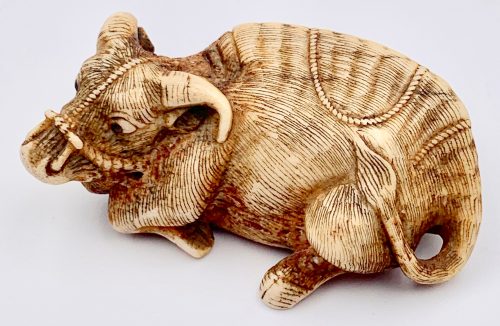 Stag antler netsuke of a recumbent ox. Signed: Tomomasa [友政]. Circa 1800. Dimensions: 56.1 x 20.7 x 36.8 mm Just speculation: There was a master in Kyoto named Tomotada who made netsuke with a recumbent ox motif. Our Tomomasa may be an epigone of a later date. Some even attribute the master to Meiji period. Provenance: Charles Ephrussi (1849-1905) acquired in the 1870s; a wedding gift in 1898 to his cousin Ritter Viktor von Ephrussi (1860-1945) and Baroness Emilie (Emmy) Schey von Koromla (1879-1938); retrieved post-war by their daughter Elizabeth de Waal (1899-1991); given by her to her brother Ignaz (Iggie) Ephrussi (1906-1994), Tokyo; bequeathed by him to his great-nephew Edmund de Waal (born 1964), London, author of “The Hare with Amber Eyes: a hidden inheritance”. London / New York: Chatto & Windus / Farrar, Straus & Giroux. ISBN 978-0099539551. https://en.wikipedia.org/wiki/Charles_Ephrussi. https://en.wikipedia.org/wiki/Ephrussi_family. https://en.wikipedia.org/wiki/Edmund_de_Waal.
Stag antler netsuke of a recumbent ox. Signed: Tomomasa [友政]. Circa 1800. Dimensions: 56.1 x 20.7 x 36.8 mm Just speculation: There was a master in Kyoto named Tomotada who made netsuke with a recumbent ox motif. Our Tomomasa may be an epigone of a later date. Some even attribute the master to Meiji period. Provenance: Charles Ephrussi (1849-1905) acquired in the 1870s; a wedding gift in 1898 to his cousin Ritter Viktor von Ephrussi (1860-1945) and Baroness Emilie (Emmy) Schey von Koromla (1879-1938); retrieved post-war by their daughter Elizabeth de Waal (1899-1991); given by her to her brother Ignaz (Iggie) Ephrussi (1906-1994), Tokyo; bequeathed by him to his great-nephew Edmund de Waal (born 1964), London, author of “The Hare with Amber Eyes: a hidden inheritance”. London / New York: Chatto & Windus / Farrar, Straus & Giroux. ISBN 978-0099539551. https://en.wikipedia.org/wiki/Charles_Ephrussi. https://en.wikipedia.org/wiki/Ephrussi_family. https://en.wikipedia.org/wiki/Edmund_de_Waal. -

Oblong round shape (nagamaru-gata) tsuba with design of dragonfly (tombo or katsumushi) and wheel (kuruma) in negative openwork (kage-sukashi), round rim (maru-mimi ). Copper sekigane.
Okamoto Yasukazu's Owari to Mikawa no tankō, №181 characterizes the tsuba as follows: "Katsumushi, kuruma-sukashi no zu (dragonfly and wheel sukashi). Mei: Yamakichibei (Shodai). Such small tsuba are rare for the Shodai. The nakago-ana is also small so it was probably intended to be mounted on a tantō. Regardless of its size, the iron is outstanding and the workmanship shows the characteristic features of the Shodai (first generation). The kuruma-sukashi design is interpreted here in a half-moon shape and only on one side of the tsuba. Such a design is also seen on works of the Nidai (second generation)...". Signed to the left of nakaga-ana: Yamakichibei (山吉兵へ). Attributed to the First Generation (Shodai) master.
NBTHK paper (translated by Markus Sesko): The Tokubetsu-Kichō Kodōgu. Kachimushi-kuruma sukashi-tsuba (勝虫車透鐔) - Tsuba with sukashi motif of dragonfly and cartwheel. Signed: Yamakichibei (山吉兵). Iron, marugata, ko-sukashi. Issued on April 1, 1977. [Copy only] Dimensions: H: 66 mm; W: 63.2 mm; Th(center): 3.8 mm; Th(rim): 3.5 mm. Weight: 68 g. -
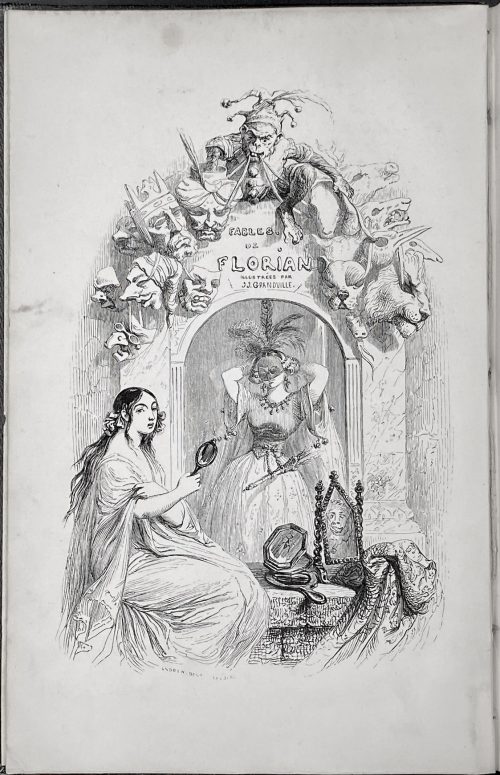 FABLES | DE FLORIAN | ILLUSTRÉES | PAR J.-J. GRANDVILLE , | SUIVIES | DE TOBIE ET RUTH , | Poëmes tirés de l'Ecriture Sainte | ET | PRECEDEES D'UNE NOTICE SUR LA VIE ET LES OUVRAGES DE FLORIAN , | PAR P.-J. STAHL. | [Vignette] PARIS. | J.-J. DUBOCHET ET Cie , ÉDITEURS , | 1842. Pagination: ffl, [2 blanks] [i, ii - ht/imp.] [2 - blank/engr. t.p. by Grandville] [iii, iv - t.p./blank] [v] vi-xx; 2 sheets of plates, [3] 4-292, bfl; engraved t.p. + [79] leaves of plates + 5 faux t.p. (total 85 plates) Size: In-8vo, 23.8 x 15 cm. Binding: Orig. blind-stamped navy cloth with gilt Grandville characters to boards and spine. First edition, first printing. Reference: Léopold Carteret (Le trésor du bibliophile. Epoque romantique. 1801-1875 / Livres illustrés du XIXe siècle. – Paris: L. Carteret; imprim. Lahure, 1927). Wood engravers: Adolphe Best (French, 1808 – 1860): 22 plates Louis-Henri Brévière (French, 1797 – 1869): 3 plates Brugnot (French, active 19th century): 7 plates Prosper-Adolphe-Léon Cherrier (French, born 1806): 6 + Tobie et Ruth + vignettes Louis Dujardin (French, 1808 – 1859): 2 plates Monogram GO–> (possibly for Godard) : 1 plate Halley-Hiback (French, 19th century): 1 + vignette Henri-Désiré Porret (French, 1800–1867): 2 + vignette Lacoste père et fils aîné et Auguste-Alexandre Guillaumot (French, 1815 – 1892): 5 plates Quichon (French, 19th century): 10 plates + Tobie et Ruth François Rouget (Belgian, born bef., 1825): 19 + vignette Unsigned or with an illegible signature: 6 plates
FABLES | DE FLORIAN | ILLUSTRÉES | PAR J.-J. GRANDVILLE , | SUIVIES | DE TOBIE ET RUTH , | Poëmes tirés de l'Ecriture Sainte | ET | PRECEDEES D'UNE NOTICE SUR LA VIE ET LES OUVRAGES DE FLORIAN , | PAR P.-J. STAHL. | [Vignette] PARIS. | J.-J. DUBOCHET ET Cie , ÉDITEURS , | 1842. Pagination: ffl, [2 blanks] [i, ii - ht/imp.] [2 - blank/engr. t.p. by Grandville] [iii, iv - t.p./blank] [v] vi-xx; 2 sheets of plates, [3] 4-292, bfl; engraved t.p. + [79] leaves of plates + 5 faux t.p. (total 85 plates) Size: In-8vo, 23.8 x 15 cm. Binding: Orig. blind-stamped navy cloth with gilt Grandville characters to boards and spine. First edition, first printing. Reference: Léopold Carteret (Le trésor du bibliophile. Epoque romantique. 1801-1875 / Livres illustrés du XIXe siècle. – Paris: L. Carteret; imprim. Lahure, 1927). Wood engravers: Adolphe Best (French, 1808 – 1860): 22 plates Louis-Henri Brévière (French, 1797 – 1869): 3 plates Brugnot (French, active 19th century): 7 plates Prosper-Adolphe-Léon Cherrier (French, born 1806): 6 + Tobie et Ruth + vignettes Louis Dujardin (French, 1808 – 1859): 2 plates Monogram GO–> (possibly for Godard) : 1 plate Halley-Hiback (French, 19th century): 1 + vignette Henri-Désiré Porret (French, 1800–1867): 2 + vignette Lacoste père et fils aîné et Auguste-Alexandre Guillaumot (French, 1815 – 1892): 5 plates Quichon (French, 19th century): 10 plates + Tobie et Ruth François Rouget (Belgian, born bef., 1825): 19 + vignette Unsigned or with an illegible signature: 6 plates -
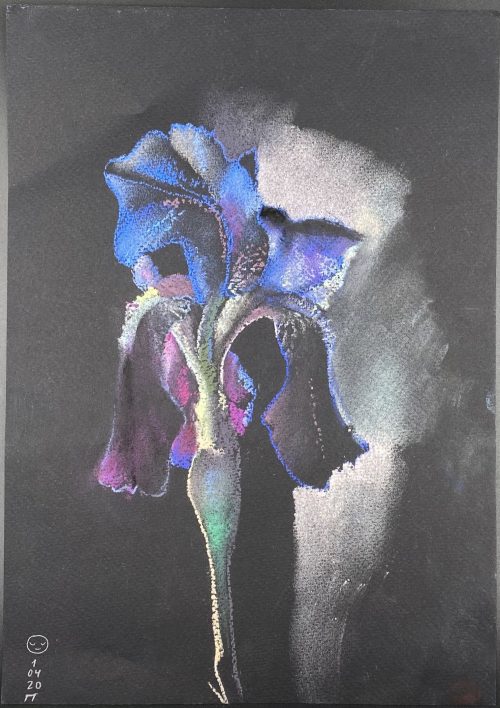 Polina de Mauny [Vladimirova] (Russian, French, b. 1981). Dry pastel on black paper. Size: 30 x 21 cm.
Polina de Mauny [Vladimirova] (Russian, French, b. 1981). Dry pastel on black paper. Size: 30 x 21 cm. -
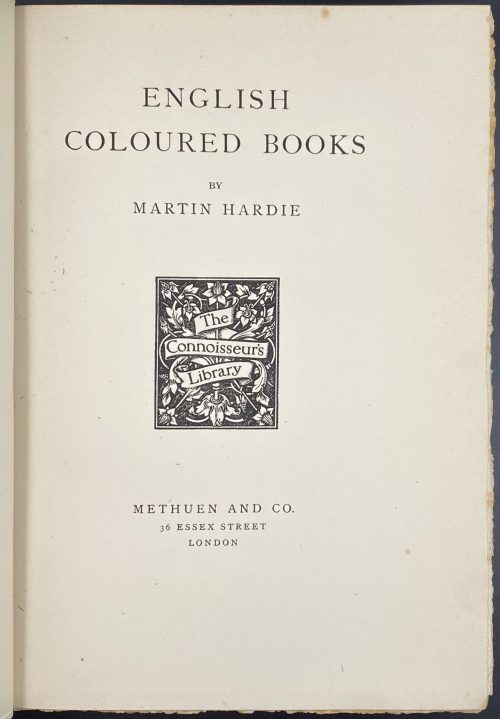 Half-title: THE CONNOISSEURS LIBRARY | GENERAL EDITOR : CYRIL DAVENPORT | […] | ENGLISH COLOURED BOOKS || Title: ENGLISH | COLOURED BOOKS | BY | MARTIN HARDIE | [device: THE CONNOISSEURS LIBRARY] | METHUEN AND CO. | 36 ESSEX STREET | LONDON || Dedication: TO MY WIFE | LOVE’S LABOUR : LOVE’S GIFT Pagination: ffl [i, ii] – h.t. / blank, [2] – blank / frontis. In colour, [iii, iv] – t.p. / First Published in 1906, [v, vi] – dedication / blank, vii-xxiv; 1-339 [340] bfl; 27 sheets of plates, colour and b/w. Collation: 8vo; a8 b4 A-X8 Y2. Binding: Hardcover, 26.3 x 19 x 5.7 cm; red cloth, blind-stamped with repeated fleuron, gilt floral designs and lettering in the frame to front cover, elaborate gilt floral design and lettering to spine; top margin gilt, other untrimmed, some pages uncut; plates w/guards. Printed on laid paper. Printed in Scotland by T. and A. Constable, at the Edinburgh university press. Contributors: Martin Hardie (British, 1875 – 1952) – Author Cyril Davenport (British, 1848 – 1941) – Editor of the series Sir Algernon Methuen (British, 1856 – 1924) – Publisher Thomas Constable (British, 1812 – 1881); Archibald Constable (British, 1774 – 1827) – Founders of the Publishing House "T. and A. Constable".
Half-title: THE CONNOISSEURS LIBRARY | GENERAL EDITOR : CYRIL DAVENPORT | […] | ENGLISH COLOURED BOOKS || Title: ENGLISH | COLOURED BOOKS | BY | MARTIN HARDIE | [device: THE CONNOISSEURS LIBRARY] | METHUEN AND CO. | 36 ESSEX STREET | LONDON || Dedication: TO MY WIFE | LOVE’S LABOUR : LOVE’S GIFT Pagination: ffl [i, ii] – h.t. / blank, [2] – blank / frontis. In colour, [iii, iv] – t.p. / First Published in 1906, [v, vi] – dedication / blank, vii-xxiv; 1-339 [340] bfl; 27 sheets of plates, colour and b/w. Collation: 8vo; a8 b4 A-X8 Y2. Binding: Hardcover, 26.3 x 19 x 5.7 cm; red cloth, blind-stamped with repeated fleuron, gilt floral designs and lettering in the frame to front cover, elaborate gilt floral design and lettering to spine; top margin gilt, other untrimmed, some pages uncut; plates w/guards. Printed on laid paper. Printed in Scotland by T. and A. Constable, at the Edinburgh university press. Contributors: Martin Hardie (British, 1875 – 1952) – Author Cyril Davenport (British, 1848 – 1941) – Editor of the series Sir Algernon Methuen (British, 1856 – 1924) – Publisher Thomas Constable (British, 1812 – 1881); Archibald Constable (British, 1774 – 1827) – Founders of the Publishing House "T. and A. Constable". -
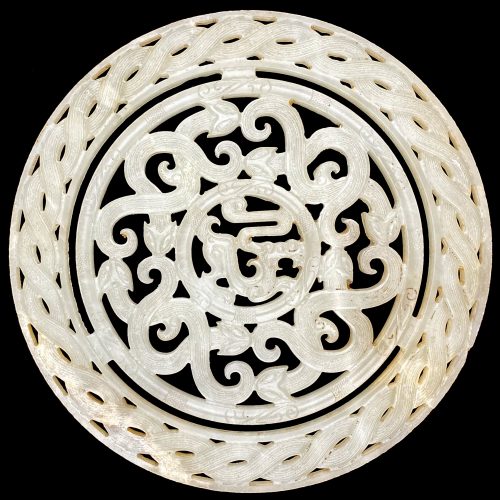 White jade Bi of three concentrical circles: double helix outer, intertwined serpents in the middle and a dragon in centre, carved in openwork and low-relief. China, the Ming Dynasty [大明] (1368 – 1644). Diameter: 15.9 cm; Height: 0.5 cm.
White jade Bi of three concentrical circles: double helix outer, intertwined serpents in the middle and a dragon in centre, carved in openwork and low-relief. China, the Ming Dynasty [大明] (1368 – 1644). Diameter: 15.9 cm; Height: 0.5 cm.


